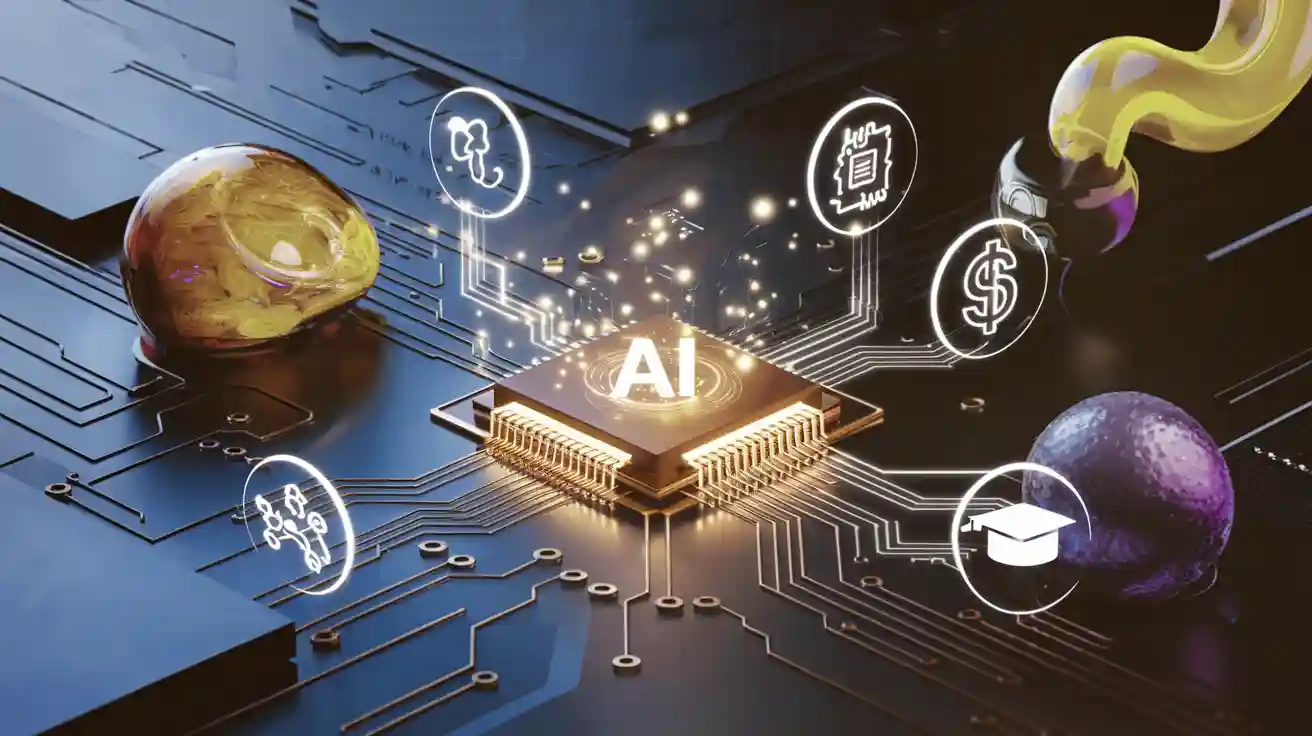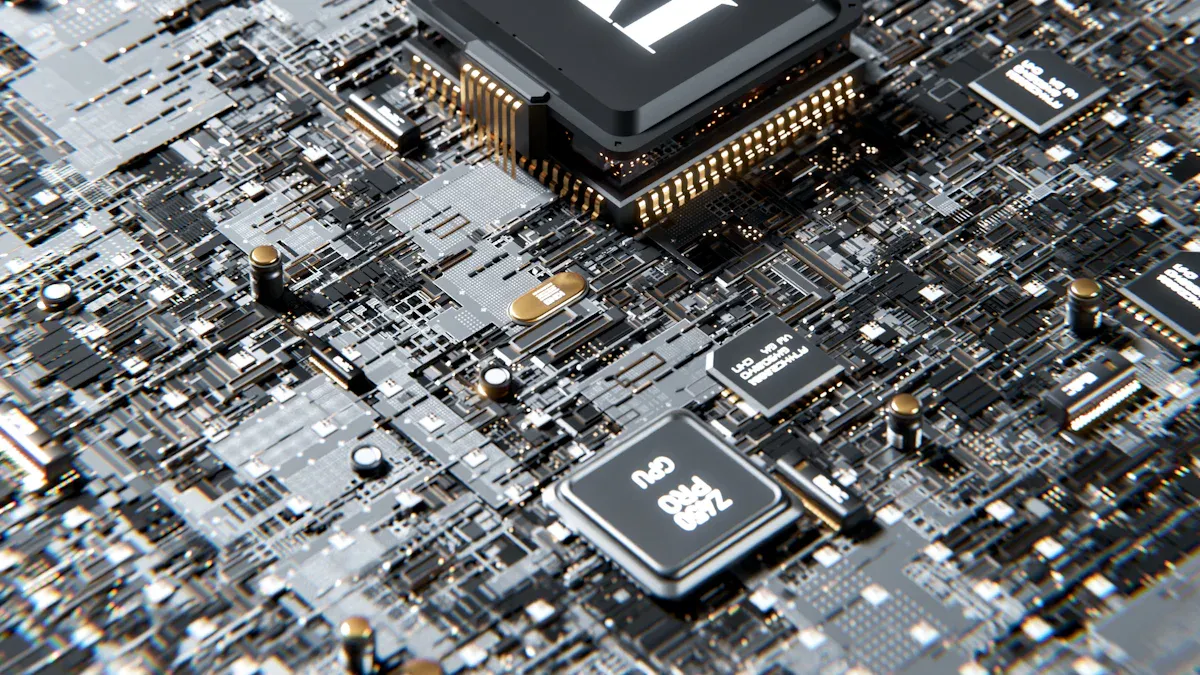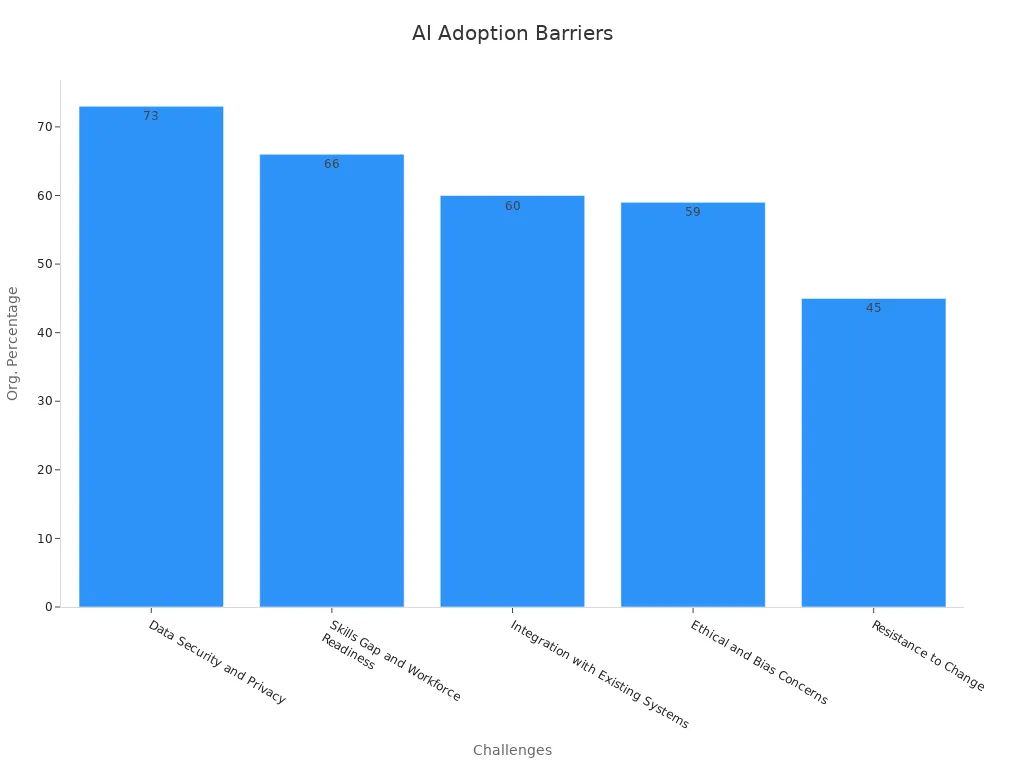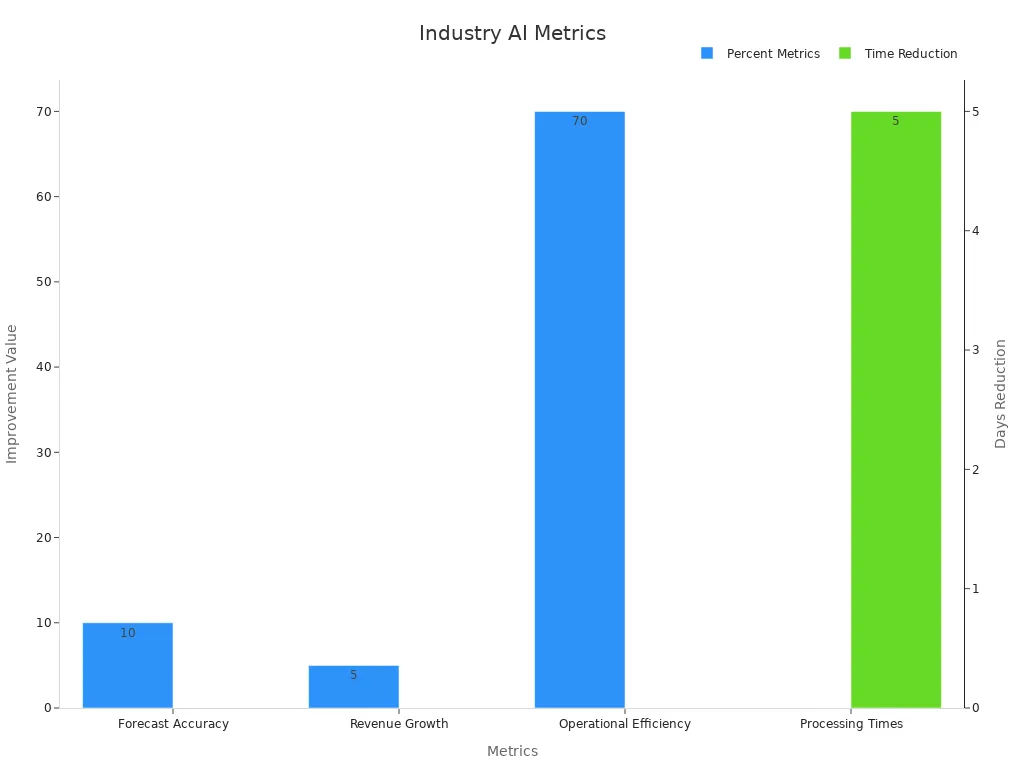
Generative AI is revolutionizing how you interact with technology and industries. It generated $67 billion in revenue in 2023, a 68% rise from 2022. By 2032, this market could grow nearly 20 times larger. With 92% of Fortune 500 companies already using OpenAI technology, artificial intelligence is reshaping workflows and driving efficiency.
Key Takeaways
-
Generative AI is quickly changing industries and growing fast. By 2032, its market size may grow nearly 20 times bigger.
-
Businesses using generative AI see big improvements. Customer support workers are 14% more productive, and developers work 88% faster.
-
To use generative AI well, companies must solve problems like keeping data safe and training workers to use it.
How Generative AI is Transforming Industries

Industries Impacted by Generative AI
Generative AI is reshaping industries by introducing innovative solutions that enhance efficiency, creativity, and decision-making. You can see its impact across sectors such as healthcare, finance, retail, and manufacturing.
-
Healthcare: AI-driven imaging tools improve diagnostics, while personalized medicine tailors treatment plans to individual patients.
-
Finance: AI models simulate financial scenarios, enabling better decision-making and fraud detection. Intelligent chatbots streamline customer service.
-
Retail: Generative AI optimizes customer experiences with personalized shopping recommendations and virtual product design.
-
Manufacturing: AI-driven solutions enhance product development and predictive maintenance, reducing downtime and increasing efficiency.
These industries are leveraging AI technology to address complex challenges, driving business transformation and unlocking new opportunities for growth.
Examples of Industry Transformation
Generative AI is not just a theoretical concept; it is actively transforming industries with measurable outcomes. Consider these examples:
|
Industry |
Impact Description |
|---|---|
|
IT |
Generative AI disrupts coding, data analysis, and testing jobs, offering predictive maintenance capabilities. |
|
Finance |
AI enhances algorithmic trading, automated credit scoring, and fraud detection in insurance claims. |
|
Advertisement |
AI creates personalized ads and optimizes content across channels based on performance data. |
|
Customer Service |
AI chatbots provide advanced support, predicting issues and offering tailored recommendations. |
|
Retail |
AI enables virtual try-ons and innovative packaging solutions, improving customer experience and reducing returns. |
Specific case studies further illustrate the transformative power of generative AI:
-
The Fabricant: This company uses generative AI for virtual clothing design, reducing waste and creating new revenue streams.
-
Kensho Technologies: By employing AI for market analysis, Kensho improves prediction accuracy and helps investors optimize portfolios.
-
Amper Music: Generative AI enables music composition, making production accessible to non-musicians.
The measurable improvements in manufacturing highlight the tangible benefits of AI-driven solutions:
|
Metric |
Before AI Implementation |
After AI Implementation |
Improvement |
|---|---|---|---|
|
Overall Equipment Effectiveness (OEE) |
67% |
89% |
+33% |
|
Scrap Rate |
3.8% |
1.2% |
-68% |
|
Changeover Time |
42 minutes |
18 minutes |
-57% |
|
Energy Cost per Unit |
$2.17 |
$1.68 |
-23% |
|
Production Planning Time |
16 hours/week |
3 hours/week |
-81% |
Major corporations are also experiencing significant transformations:
-
Rolls-Royce: Generative AI analyzes sensor data to predict engine issues, ensuring safety and timely maintenance.
-
BMW: AI inspects products for flaws, enhancing quality and reducing human error.
-
Honeywell: AI optimizes production plans, improving operational strategies and customer satisfaction.
Generative AI is driving innovation across industries, enabling businesses to achieve higher efficiency, better quality, and faster processes.
How Generative AI is Changing Workflows

Boosting Efficiency and Productivity
Generative AI is revolutionizing workflows by automating repetitive tasks, optimizing resource allocation, and enhancing decision-making processes. You can see its impact across industries, where AI-powered tools are driving measurable improvements in productivity. For example, customer support agents using generative AI have experienced a 14% increase in efficiency, while highly skilled workers have seen productivity gains of up to 40%.
|
Industry/Role |
Percentage Improvement |
|---|---|
|
Customer Support Agents |
14% |
|
Lowest Skilled Workers |
35% |
|
Highly Skilled Workers |
40% |
|
Average Across Uses |
20% |
Generative AI solutions are also transforming software development. Developers using AI tools report an 88% increase in productivity, completing 126% more projects weekly. In customer service, AI-driven solutions help workers resolve inquiries faster, with new agents achieving expert-level productivity four times faster than before.
|
Source |
Evidence |
|---|---|
|
Moveworks |
Generative AI can reshape organizations by automating tasks and optimizing resource allocation. |
|
Artsmart |
Developers using AI tools see an 88% increase in productivity. |
|
Artsmart |
AI-powered developers complete 126% more projects weekly. |
|
Artsmart |
Customer service workers using AI are 13.8% more productive. |
|
NoJitter |
Access to AI tools increases productivity by 14% on average. |
|
NoJitter |
Employers believe AI could boost productivity by 47%. |
|
NoJitter |
AI increased speed by more than 25% and task completion by more than 12%. |
|
NoJitter |
ChatGPT improved output quality for low-ability workers while reducing time spent. |
Generative AI is not just about speed; it also improves the quality of work. In writing business documents, low-scoring writers have narrowed the quality gap with high-scoring peers by 2-3 points. This demonstrates how AI technology can elevate performance across skill levels, making workflows more efficient and inclusive.
Driving Creativity and Innovation
Generative AI is not only about efficiency; it is also a catalyst for creativity and innovation. You can see its transformative power in industries like product design, where companies like BMW and Airbus have achieved groundbreaking results. BMW used generative AI to create components that are 30% lighter with superior performance. Similarly, Airbus designed a partition wall that is 45% lighter than traditional designs, showcasing how AI can redefine engineering possibilities.
|
Breakthrough Area |
Example Company |
Result/Statistic |
|---|---|---|
|
Product Design |
BMW |
Components were 30% lighter and had superior performance characteristics. |
|
Product Design |
Airbus |
Partition wall was 45% lighter than conventional designs. |
|
Mass Customization |
Adidas |
Personalized footwear tailored to individual biomechanical data. |
|
Maintenance Optimization |
GE Healthcare |
Reduced service costs by 12% and increased equipment availability by 8%. |
|
Quality Control |
Continental Automotive |
Achieved 99.8% defect detection accuracy and reduced inspection times by 80%. |
|
Supply Chain Management |
Procter & Gamble |
Reduced inventory costs by 20% while maintaining higher service levels. |
Generative AI also enables mass customization, allowing companies like Adidas to create personalized footwear based on individual biomechanical data. This level of customization was previously unimaginable at scale. In quality control, Continental Automotive achieved a 99.8% defect detection accuracy, reducing inspection times by 80%. These examples highlight how AI-driven solutions are pushing the boundaries of what is possible, fostering a new era of innovation.
In the future of work, generative AI will continue to play a pivotal role in transforming workflows. By combining efficiency with creativity, it empowers you to achieve more while unlocking new opportunities for growth and exploration.
Challenges and Limitations of Generative AI
Barriers to Adoption
Generative AI holds immense potential, but several barriers hinder its widespread adoption. Many organizations struggle with data security and privacy, as 73% report concerns about protecting sensitive information. Ethical issues, such as bias in AI-generated outputs, also raise red flags. For example, generative AI can unintentionally perpetuate societal biases, leading to distorted results and ethical dilemmas. The opacity of AI decision-making processes further complicates trust and interpretability.
Another significant challenge is the skills gap. Around 66% of organizations cite workforce readiness as a barrier, highlighting the need for skilled professionals to manage and implement AI solutions. Integration with existing systems also poses difficulties, with 60% of companies reporting challenges in aligning AI with their current infrastructure. Resistance to change remains a hurdle, as 45% of organizations face internal pushback when adopting new technologies.
|
Challenge |
Percentage of Organizations Reporting |
|---|---|
|
Data Security and Privacy |
73% |
|
Skills Gap and Workforce Readiness |
66% |
|
Integration with Existing Systems |
60% |
|
Ethical and Bias Concerns |
59% |
|
Resistance to Change |
45% |

Overcoming Challenges in Implementation
Despite these barriers, industries are finding ways to overcome challenges and unlock the full potential of generative AI. Improving data quality is a top priority. High-quality data ensures reliable outcomes, reducing the risk of biased or inaccurate results. Organizations are also investing in robust data management systems to handle large datasets effectively.
Training and upskilling employees play a crucial role in addressing the skills gap. Companies are offering specialized programs to equip their workforce with the knowledge needed to implement AI solutions. Additionally, advancements in AI transparency are helping build trust. By making AI models more explainable, businesses can foster confidence among stakeholders.
The benefits of overcoming these challenges are evident. For instance, industries have reported a 10% improvement in forecast accuracy, a 50% reduction in processing times, and significant cost savings through automation. These metrics highlight how addressing barriers can lead to measurable success.
|
Metric |
Description |
|---|---|
|
Forecast Accuracy Improvement |
Increase in forecast accuracy, e.g., from 85% to 95% accuracy in revenue forecasts. |
|
Reduction in Processing Times |
Time reduction for financial processes, e.g., from 10 days to 5 days for month-end close. |
|
Cost Savings |
Savings from automation, including reductions in labor and operational expenses. |
|
Revenue Growth |
Revenue increases from AI insights, e.g., a 5% increase in annual revenue. |
|
Operational Efficiency |
Productivity increases, e.g., reducing manual data entry tasks by 70% through AI. |

By addressing these challenges, you can harness the transformative power of generative AI to drive innovation and efficiency in your organization.
Generative AI is reshaping industries and workflows, driving innovation and efficiency. You can see its transformative impact in areas like synthetic data generation, which 75% of companies will adopt by 2026. With venture capital investments reaching $3.9 billion in Q3 2024, the economic potential of generative AI could exceed $7.9 trillion annually.
FAQ
What is generative AI, and how does it work?
Generative AI creates new content like text, images, or music by learning patterns from existing data. It uses machine learning models, such as neural networks, to generate outputs.
Can generative AI replace human creativity?
Generative AI enhances creativity by providing tools and ideas. It doesn’t replace human creativity but complements it, enabling you to achieve innovative results faster and more efficiently.
Is generative AI safe to use?
Generative AI is safe when used responsibly. You should ensure data privacy, avoid biased outputs, and follow ethical guidelines to minimize risks and maximize benefits.








